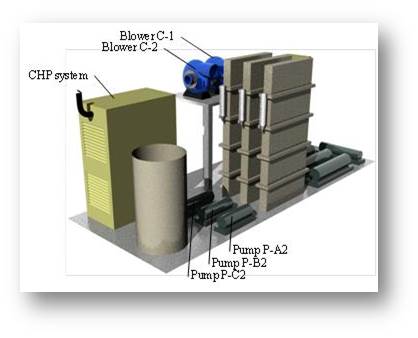-
Life Memory Project
> Project
> Life Memory Project
>
Actions
Project Actions
The development of MEMORY project is divided into different actions as they are listed below:
A – Preparatory actions:
The main objective of this action is to establish the most adequate configuration and location for the demonstration prototype plant.
A.1 – Selection of the demonstrator's site and authorization requests (Finished)

A.2 – Assessment of the prototype configuration (Finished)


B - Implementation actions:
B.1 – Prototype plant design and construction (Finished)
This first implementation action comprises all the activities that are necessary for the construction of the anaerobic treatment demonstration plant and its placement in the selected WWTP: Detailed design of the demonstration plant and Construction of the demonstration plant.

B.2 – Prototype plant implementation and follow-up (Finished)
The main objective of this action is to evaluate the overall process performance (focusing on effluent water quality obtained and energy balances) and to test different operation conditions in order to find the optimal performance and critical parameters. Specific aspects of the implication of this technology at full scale will be also studied, such as the importance of methane recovery from the effluent and the biogas use in a CHP system. Finally, different guidelines will be obtained for an optimum design and operation at full scale, as well as for monitoring and controlling the process. This action includes: Process implementation and start-up, Prototype operation, Prototype simulation and optimization, Control systems development and implementation, and Economic feasibility study.
C – Monitoring of the impact of the project actions:
C.1 – Effectiveness of the project actions. Project technical results monitoring (Finished)
The project contains a set of specific actions/tasks/activities to perform unbiased estimations of the impact of LIFE MEMORY in the environmental issue targeted: validation and demonstration of SAnMBR technology application in WWTPs for energy and water recovery.
C.2 – Monitoring the environmental impacts (Finished)
The objective of this action is the monitoring of the equipment and the entire prototype in terms of performance and environmental targets. The activities conducted under this action will indicate if the functioning of the equipment is producing the expected results in terms of energy consumption, related CO2 emissions and carbon footprint of equipment. Any deviation will be carefully analyzed in order to implement the corrective actions in the implementation actions.
C.3 – Monitoring of the socio-economic impact of the project (Finished)
The socio-economic impact will be addressed by analyzing the benefits of the project in terms of employment, economic effects over the value chain and impact on the local environment (neighborhood).
D – Communication and dissemination actions:
D.1 – Project website (Finished)
The objective of this action is the development of a project website that will ensure a dissemination of the project via electronic media with a specific focus on its environmental benefits, both during the project lifetime and after its termination. http://www.life-memory.eu/
D.2 – LIFE+ information boards (Finished)
The objective of this action is the preparation of the LIFE+ information boards providing key information about the project, to be installed at the site of prototype implementation and displayed at other public locations.
D.3 – Layman's report (Finished)
The objective of this action is the issuing of the Layman's report at the end of the project that will report all the objectives, actions and results of the project to the general public and all potential clients of Aqualia.
D.4 – Communication and dissemination actions (Finished)
The objective is to disseminate widely our communication tools in order to maximize the reached audience both during the project's lifetime and after its termination.
Contact with public stakeholders will be made in the frame of proposed conferences and seminars, as well as the fairs and exhibitions, in which representatives of Aqualia, KOCH and Calagua shall participate during the project. These events are chosen in such way, that we will be able to reach a high number of relevant stakeholders for an effective dissemination of the project.
E – Project management and monitoring of the project progress:
E.1 – Overall project management (Finished)
The objective of this action is to ensure a smooth and efficient management of the project during its entire duration from a technical, administrative and financial point of view.
The main objectives are to ensure the achievements of the project objectives within the budget and the time appointed; to define the technical architecture of the project and its consistency throughout the project; to track and report the technical and financial progress and the quality of the work; to ensure the use of the available resources in a structured manner; to monitor the communication with the subcontractors and to follow an efficient dissemination activities.
E.2 – Networking with other projects (Finished)
The objective of this action is to ensure an effective networking with other projects, to a mutual benefit, not only during the project duration but also after its termination. The main objective will be the transfer of knowledge and information exchange with the professionals of the area and of the LIFE+ program.
E.3 – After-LIFE Communication Plan (Finished)
The objective of this action is the definition and implementation of an action plan to pursue the dissemination and communication of the project's results after its conclusion. The main goal is to communicate project's progress and results, which will be of benefit to many industries and municipalities by providing them an innovative solution for reducing the environmental impact, and trigger authorities to reduce pollutant's emissions and enhance water and energy recovery.
E.4 – Audit of LIFE+ expenses (Finished)
XXI century: From wastewater to Resource Source
Towards a new paradigm based on sustainability, where wastewater now turns into a source of energy, nutrients and simultaneously, a water resource suitable for reuse.
In this context, LIFE MEMORY project targets for the sustainable production of reusable water demonstrating the feasibility of an innovative technology: the Submerged Anaerobic Membrane Bioreactor (SAnMBR).




